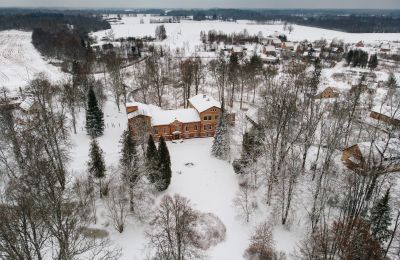Spectacular 504 years old manor estate complex in northern Latvia awaiting its renaissance!
The estate has a fabulous 150-year-old park with oak, ash, larch, white spruce, pine, birch, maple, lime and aspen trees.
Whether you just want to get away from the hustle and bustle of the city or are looking for a place for a special occasion in your life, Virkenu Manor, surrounded by forests and set on a hill, will become a place for truly peaceful days and nights.
The property consists of 27,01 ha (270 100 m²) of land and 6 buildings:
The Lords House (built in 1895) with a total area of 1275 m²;
The Servant's House (built in 1860) with a total area of 462 m²;
The Smithy (built in 1860) with a total area of 115 m²;
Outbuilding (built 1883) with a total area of 419 m²;
Large cattle barn (built 1860) with a total area of 999 m²;
The Brewhouse (built 1860) with a total area of 252 m².
The History of the Virkeni Manor
Historical names: Wirken, Wirkken, Würken, Würkenhoff. Created in 1520.
The 16th Century
In 1520, on the orders of Wolter von Plettenberg, the Livonian Order master, several land parcels were leased to Kuddelen, who merged them and created a manor.
The next owner of the manor was the von Dönhoff family – a well-known Baltic German family: the father, Gerard von Dönhoff, was the Governor of Tartu in 1598 and his sons, in turn Caspar von Dönhoff, a diplomat and a favourite of the Polish King Zigismund III Vases, was governor of Tartu (in today’s Estonia) and Sieradza (in today’s Poland) and Ernst Magnus von Dönhoff was the castellan of Parnu and Tartu.
The 17th Century
In 1690, the Manor was taken away based on a decision by Swedish King Karl XI, but soon afterwards was returned.
The First Half of the 17th Century – during the Swedish reign (Svenska Livland) from 1629 to 1721) the Manor belonged to the Engelhardt family. The first owner was a Swedish army cavalry lieutenant, the Vidzeme nobleman Michael von Engelhardt (who also owned the Endzele Manor). He received the manor as a gift from Swedish King Gustav II Adolf in gratitude for his faithful and long-time war service.
The 18th Century
The 18th Century – The Virkeni Manor continued to be owned by the von Engelhardt family, who successfully managed it.
The 19th Century
From 1820 the Manor was run by artillery lieutenant and assessor Anton Johan II von Engelhardt (1788 to 1874) and his wife Sophie Magdalena Helene von Numers (1787 to 1848).
Later, Virkeni Manor was inherited by Anton Johan’s II son Baron Karl Gustav Georg von Engelhardt (1811 to 1887) who was married to Eveline Katherine von Engelhardt (1826 to 1853) in 1850.
In 1820, the Manor’s territory was the residence of 324 inhabitants (154 men and 170 women), while in 1860, according to the Rujiene Church Convent’s minutes, 249 inhabitants lived on the Virkeni Manor.
From 1859 to 1861, the Neo-Latvian movement’s participant Jekabs Zvaigznite (1833 to 1867) worked as a tutor at the Virkeni Manor for Baron Karl Gustav Georg von Engelhardt’s (1811 to 1887) sons Karl Anton von Engelhardt (1851 to 1923) and Hermann Gustav von Engelhardt (1853 to 1914). At the time that he worked at the Virkeni Manor, he was a colleague of Juris Alunans, publishing the work „Seta, Daba, Pasaule” (The Farmstead, Nature and the World) (1860). Immediately afterwards (in 1862) he became a member of the editorial staff at the „Peterburgas Avizes” (The Peterburg Newspaper).
Karl Anton von Engelhardt began construction of a new Castle in the early 1890s, but his brother Hermann Gustav von Engelhardt left to study art in Germany and later became a well-known painter.
The last owner of the Virkeni Manor, Karl Anton von Engelhardt, who was connected with Russia’s emperor Aleksander II Romanov, lived abroad (Germany and Austria) from 1895 and rented the manor to his godson, the German cultivator Gustav Berkmann (1860 to 1931) for 300 roubles a year. From 1895 to 1910 Berkmann rented out the second floor of the Manor to Graf Treimanis from St. Petersburg.
The 20th Century
In 1920, the 704 ha large Virkeni Manor was taken over by the Latvian state and included in the State’s Land Bank.
On 19 March 1921 the Virkeni Manor centre was allocated to the Rujiena Agriculture Association to establish the Rujiena Agriculture school (from the end of the 1920s the Rujiena Agriculture and Home Economics School).
On 16 October 1936 as a result of the liquidation of the Agriculture Association, the school became the property of the Agriculture Chamber.
After that the Virkeni Manor has always housed a professional education institutions (Rujiena Technical School No. 4 (1955-1963), Rujiena City Professional Technical School No. 10 (1963 to 1973), Rujiena Technical School No. 5 (1973 to 1984), the 68th Professional Technical High School (1984 to 1988), Virkeni Agriculture School (1988 to 1999), Rujiena Professional Gymnasium (1999 to 2006)).
























